The French word for a small, elegant box of chocolates designed to prevent the chocolates from damaging each other.
Dullness, streaks, greying, or whitish discoloration on the surface of chocolate caused by poor tempering, temperature fluctuation. Bloom is unattractive but not harmful.
(Ca-cow) The Tree from which chocolate is made.
The part of the cacao tree, found inside its pods, which is used to make chocolate.
Cacao content refers to the amount of the chocolate product that is made of the three cacao components (chocolate liquor, cocoa butter, and cocoa powder).
A dedicated area specialising in the growing of fine cacao, typically found in the Caribbean and Central or South America. Hotel Chocolat’s own Rabot Estate is on the Caribbean island of Saint Lucia.
The fruit of the cacao tree, which usually contains 20-40 cacao beans.
A rich confection made from chocolate and cream (ganache), although it may contain butter, eggs, and other flavorings. Truffles may be dipped in chocolate and or rolled in cocoa powder.
This word may be used to describe several different functions. A person who makes chocolates by hand in small batches is called a Chocolatier. A Chocolatier may be employed to evaluate beans and/or supervise the blending and roasting. In large companies, there may be as many as twenty. Chocolatiers will generally adjust blends, roasting times and other factors to create a final product that is consistent with prior products.
The familiar UK term for the tree and its harvest.
The fat that is contained within cocoa beans in to make cocoa powder.
The finely ground paste of roasted cocoa beans, a very dark brown, half–fluid mass with an amazing aroma. It is the cocoa butter within it which makes it fluid and the cocoa powder within, which gives it the colour, taste, and aroma.
The part of the cocoa bean, which is used in the production of chocolate.
Once cacao beans are fermented, dried, roasted and cracked, the nibs (center of the cocoa bean) are ground to extract about half the cacao butter, leaving a dark brown paste called chocolate liquor. After drying again, the hardened mass (press cake) is ground into the unsweetened cocoa powder which may be natural or Dutch processed. It’s available with different fat levels and a range of tastes include, mild to strong, and unsweetened, and it’s used for baking, reduced fat and calorie recipes, and ice cream flavoring.
The total amount of cocoa in chocolate usually expressed as a percentage. Leonidas recipes always contain a higher than normal cocoa solid content to keep the sugar down and allow the flavour of the cacao to really shine through.
A traditional. Energizing drink from the West Indies. Made by melting mashed up roasted cocoa beans into milk. As served at the Rabot Estate store in London’s Borough Market.
A mechanical kneading process which improves the texture and taste of chocolate by driving out astringency. Conching time is the amount of hours the chocolate spends in this process and can vary from 12 hours to 120 hours.
The basic chocolate product, in large solid blocks, or in liquid form, which a chocolatier transforms into moulded bars or filled chocolate recipes.
The finest and rarest cacao bean, representing only 5% of the world’s crop, thought to have originated in Mexico. The beans produced on Hotel Chocolat’s Rabot Estate are criollo-rich Trinitario.
The name that Rabot estate gives to its “roll-up-the-sleeves and get involved” ethical programme, which provides sustainable support to cacao farmers in Ghana and Saint Lucia.
The process to give individual chocolates an outer chocolate coating by being passed through a waterfall of molten chocolate.
One of the most important and skilful steps of the cacao harvesting process, during which the sweet pulp from the cacao pod naturally heats up and creates a chemical change in the beans, making them less bitter and starting to taste a bit like chocolate.
A praline textured with small pieces of crispy, oven baked biscuits.
The mainstay of the world’s cacao bean crop (80%), with a robust flavour, thought to have originated in the Amazon.
A mixture of chocolate and cream, with a velvety smooth texture.
A blend of chocolate, very finely grounded hazelnuts and sugar, generally much smoother than a praline. A Gianduja has a silky smooth texture.
A natural emulsifier made from soy, which helps increase the viscosity of chocolate so that it flows more easily when the chocolatier is working with it.
Discs of solid chocolates with luxury fruit and nuts
(PRAH- leen) A paste of crushed nuts, usually hazelnuts, caramelised sugar and chocolate.
(RA-bo) Hotel Chocolat’s 140-acre cacao estate on the island of Saint Lucia, where they are actively helping to regenerate the agricultural economy.
Cacao is grown on a single, named estate, whose distinctive flavours are directly influenced by the terroir (or environment) in which it is grown. The flavours will vary from harvest to harvest which you can readily taste with the chocolate they produce.
Cacao is grown in a single region or country, whose distinctive flavours are directly influenced by that terroir (or environment). These flavours will be less varied than the single estate, such as the Saint Lucian Island Growers chocolate, compared to the Rabot Estate.
The precisely controlled heating and cooling of molten chocolate to correctly crystallise the cocoa butter within, which produces the required consistency and a smooth, glossy finish. click the link to see the tempering process before the chocolate is placed into the mould.
(TAIR- rwah) A term that’s taken from French that describes the environmental influences that help define the character and flavour nuances of cacao, including the geographic location, the topography, the type of soil and the climate.
The term used to describe the very small band of chocolatiers who grow cacao as well as make chocolate from the bean. Goes further than ‘Bean to Bar’.
Type of cacao bean – a hybrid of Criollo and Forastero, with delicate flavours, but easier to grow than Criollo and more resistant to disease. About 15% of the world’s crop.
(also known as Kibbling) The process of removing the shells from roasted cacao beans, leaving the cocoa nibs which will be ground to make chocolate.

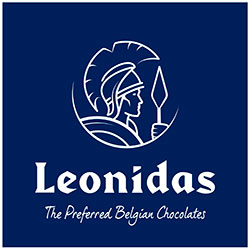
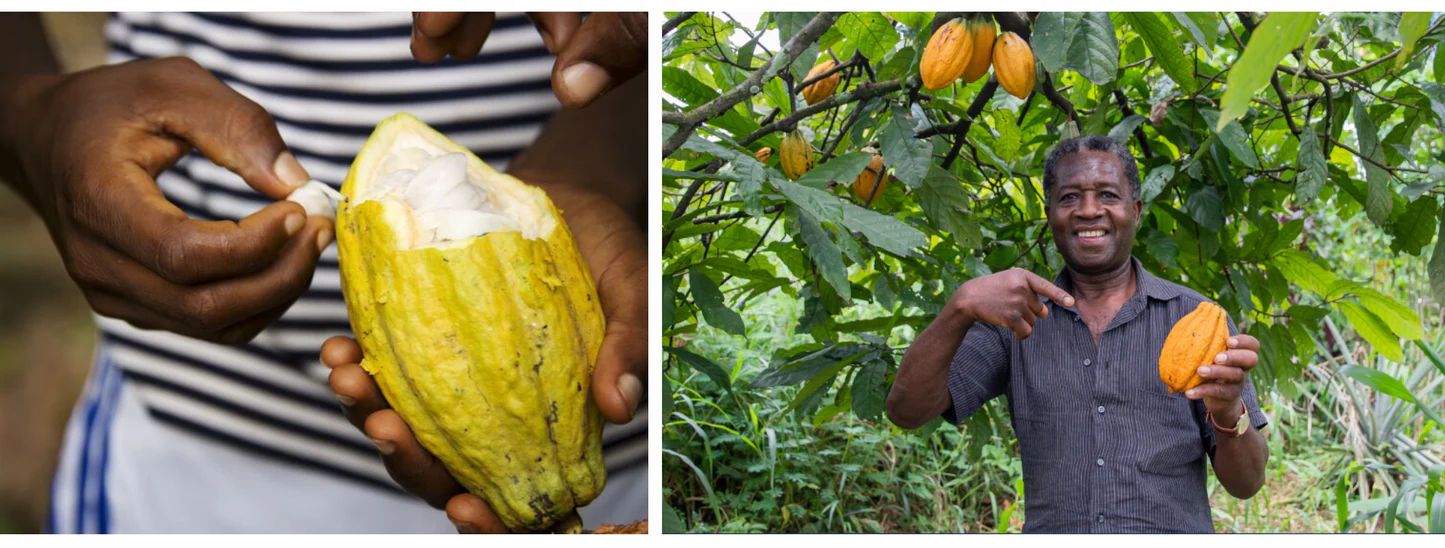
 3.000 t of cocoa bean production annually
3.000 t of cocoa bean production annually produced by 2.450 farm around the world
produced by 2.450 farm around the world over 8.526 hectares of land growing cocoa beans
over 8.526 hectares of land growing cocoa beans The programmes of the Rainforest Alliance and of Cocoa Horizons offer excellent guarantees for sustainable cocoa. This is why we have chosen to sign up to them when we began this process.
The programmes of the Rainforest Alliance and of Cocoa Horizons offer excellent guarantees for sustainable cocoa. This is why we have chosen to sign up to them when we began this process. These two labels are intended to enhance the standard of living of growers by improving the quality and yield of their production, to protect children and eliminate deforestation.
These two labels are intended to enhance the standard of living of growers by improving the quality and yield of their production, to protect children and eliminate deforestation. At the same time, we have signed the ‘Beyond Chocolate’ charter, a Belgian initiative that commits participants to fight actively against deforestation and to offer a decent income to cocoa growers.
At the same time, we have signed the ‘Beyond Chocolate’ charter, a Belgian initiative that commits participants to fight actively against deforestation and to offer a decent income to cocoa growers.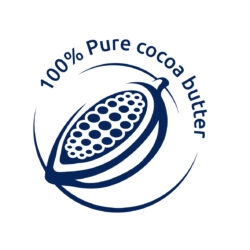 Leonidas wants you to experience moments of pure delight. That’s why our Maîtres Chocolatiers only use 100% pure cocoa butter chocolate. Pure cocoa butter chocolate is highly recommended for your mood. A Leonidas praline… and everyone smiles!
Leonidas wants you to experience moments of pure delight. That’s why our Maîtres Chocolatiers only use 100% pure cocoa butter chocolate. Pure cocoa butter chocolate is highly recommended for your mood. A Leonidas praline… and everyone smiles!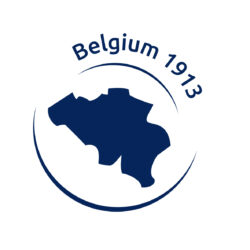 Leonidas chocolates are 100% made in Belgium. Our Maîtres Chocolatiers respect the tradition of our know-how and transform the finest ingredients with love. Whether you taste them in Paris, London or Athens, you can enjoy the Belgian (and undoubtedly the world’s) favourite chocolates.
Leonidas chocolates are 100% made in Belgium. Our Maîtres Chocolatiers respect the tradition of our know-how and transform the finest ingredients with love. Whether you taste them in Paris, London or Athens, you can enjoy the Belgian (and undoubtedly the world’s) favourite chocolates. Our Maîtres Chocolatiers are obsessed with quality. For their creations, they only want pure cocoa butter. So you won’t find a single drop of palm oil in our chocolate. It’s better for the taste and the planet!
Our Maîtres Chocolatiers are obsessed with quality. For their creations, they only want pure cocoa butter. So you won’t find a single drop of palm oil in our chocolate. It’s better for the taste and the planet!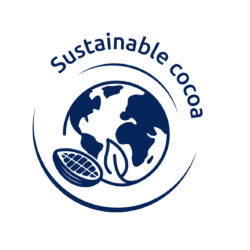 Leonidas chooses sustainable cocoa to produce its pralines. When your aim is to create moments of happiness for everyone, what’s more normal than caring about nature and humankind?
Leonidas chooses sustainable cocoa to produce its pralines. When your aim is to create moments of happiness for everyone, what’s more normal than caring about nature and humankind?